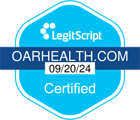What AA Doesn't Tell You

While Alcoholics Anonymous (AA) is a valid pathway of recovery that has helped many people achieve and maintain sobriety, I believe it is problematic to conceptualize alcohol use disorder (AUD) solely as a “spiritual malady.”
In my experience, as someone with over 13 years of experience in recovery and a master's in clinical social work, using such a one-size-fits-all phrase to describe and treat a mental health condition overlooks the many facets and complexities of alcohol use disorder and each person’s lived experience.
Treating AUD solely through a lens of spirituality can cause harm, lead people to return to use, and present more barriers to treatment, as I have witnessed personally in the rooms and in speaking with others about their experiences. With only one in four people with substance use disorders accessing treatment, it’s crucial to broaden our perspective about this treatable condition and the plethora of treatment options available instead of letting one pathway dominate dialogues about recovery.
In this article, I explore why I believe it’s problematic to use an outdated idea of alcohol use disorder, and share the experiences of those who think many facets of AUD are overlooked within the 12-step model.
What Is AUD?
The Big Book of Alcoholics Anonymous describes alcoholism (now called alcohol use disorder) as a disease of mind, body, and spirit. More specifically, AA literature, such as the doctor’s opinion and the foreword to the second edition, defines AUD as a “malady” for which the solution is a “spiritual remedy” outlined in the twelve-step program.
In the chapter on How It Works, it states, “When the spiritual malady is overcome, we straighten out mentally and physically.”
We’ve come a long way since the creation of AA in 1939, in terms of understanding substance use disorders (SUD). While this isn’t an article on the neuroscience of addiction, there is substantial scientific evidence that SUD is a brain disorder affecting the whole body. Chronic substance use changes the brain, flooding it with feel-good chemicals and impairing the rational decision-making part of the brain. This is why people compulsively seek alcohol or other drugs over once pleasurable activities, and continue to use drugs despite adverse consequences.
While I appreciate that a spiritual solution is effective for some people in their recovery, and respect a person’s autonomy to choose what works for them, I believe we need to broaden our understanding of SUDs, given the advances in science in terms of how we understand addiction and effective treatment options. For instance, medication-assisted treatment is considered the gold standard of treatment for opioid use disorders, not a spiritual solution.
As a clinician and a person in recovery, I do not believe it is helpful to use this conception of spiritual malady as the sole prism with which to understand and treat substance use disorders. Addiction is far more complex, often masks underlying or co-occurring conditions, and we have more updated and evidence-based treatments. I am not suggesting that we only offer evidence-based solutions.
What I am saying, however, is that evidence-based treatments should be presented as an option along a spectrum of all treatment pathways.
The Intersection Of AUD & Co-occurring Conditions
In addition to advances in the understanding of AUD as a brain condition, we also now know that substance use disorders often co-occur with other mental health diagnoses and trauma histories.
For example, teens with attention-deficit hyperactivity disorder (ADHD) are two to three times more likely to misuse substances than the general population, making them more vulnerable to addiction. That’s because alcohol and other drugs can calm the brain and make it easier to focus. Trauma often co-occurs with addiction. Research shows that up to 75 percent of individuals with substance use disorder have experienced trauma at some point in their lives.
Understanding these intersections offers an alternative explanation for a “malady” as to why someone may use substances, but it can also present challenges in recovery. Taking away the substances can make neurodivergence more pronounced, causing sensory overload, executive dysfunction, and more.
A spiritual solution cannot treat ADHD or trauma, which is why many people who have ADHD and/or autism and untreated trauma struggle with 12-step programs. This can make people internalize why they are finding it difficult and blame themselves, making them susceptible to relapse.
“I was never told that ADHD and complex PTSD are real medical conditions,” Alex told me.
She explained that in recovery, she suffered immensely with complex PTSD and ADHD symptoms, but felt that she was the problem. “I felt like I wasn’t working my program hard enough, and that was why I suffered,” she stated.
Like many individuals in twelve-step programs, participants are encouraged to rededicate themselves to the program, help others, and overcome self-centeredness. Alex shared, “I was told that if I spent too much time focusing on myself, then I was self-obsessed and needed to ‘get out of my own a**’. And so I heavily focused on others through ‘service’ as a means of escape.”
We must understand these intersections because if we don’t, we risk harming people who go to AA for help. “This was one of the most dangerous things that I was told, or not told. I was not told that it was a normal part of healing to experience anger or ‘resentment’ towards people who failed to keep me safe. Instead, I was told that my resentments were a sign of my active disease, just waiting for me to slip up and ‘use’, she explained.
Alex believed this left her feeling stunted and trapped in a repetitive loop of misery, “My CPTSD was compounded. I was reliving my childhood script again, where I was the bad one; I was defective for feeling anger.”
My experience was similar to Alex's. I attended AA and NA for the first five years of my recovery, but it became increasingly challenging. I felt burned out by the constant meetings and juggling life with sitting in church basements listening to sad stories about how defective we are. I was exhausted all the time and felt increasingly anxious and depressed. I was repeatedly told to “Go to a meeting,” “Work the steps,” and “Help a newcomer.” Those things didn’t help. When I left AA and worked with a therapist, I discovered I also had untreated trauma and neurodivergence, which could never have been treated, only exacerbated, by a spiritual solution.
While I understand that 12-step programs do not claim to treat trauma or other mental health conditions, a lack of awareness in the rooms of the intersecting conditions and the prevalence of trauma can cause harm and put people at risk of thinking they are not working their program hard enough or that they are the problem. What folks actually need is understanding, outside help, and professional treatment. I believe it’s crucial for clinicians and folks in recovery to understand this when recommending AA as the only option to recover, or when suggesting folks need to work harder when they are struggling.
Are You Drinking Too Much?
Is drinking affecting your job? Is alcohol harming your health or relationships? Does your drinking worry you? Ever tried to drink less but failed?
If any of this sounds familiar, and if AUD runs in your family, Oar Health might be right for you. Oar Health offers medication FDA-approved for the treatment of alcohol problems. A daily pill to drink less or quit.
Qualify For Treatment Sources
Farrugia, P. L., Mills, K. L., Barrett, E., Back, S. E., Teesson, M., Baker, A., Sannibale, C., Hopwood, S., Rosenfeld, J., Merz, S., & Brady, K. T. (2011). Childhood trauma among individuals with co-morbid substance use and post-traumatic stress disorder. Mental health and substance use: dual diagnosis, 4(4), 314–326. https://doi.org/10.1080/17523281.2011.598462
Frank, C. (2024). ADHD and Substance Abuse. Child Mind Institute.
Hagedorn, H., Kenny, M., Gordon, A. J., Ackland, P. E., Noorbaloochi, S., Yu, W., & Harris, A. H. S. (2018). Advancing pharmacological treatments for opioid use disorder (ADaPT-OUD): protocol for testing a novel strategy to improve implementation of medication-assisted treatment for veterans with opioid use disorders in low-performing facilities. Addiction science & clinical practice, 13(1), 25. https://doi.org/10.1186/s13722-018-0127-z
National Institute on Drug Abuse. (2025) NIDA IC Fact Sheet 2025.
National Institute on Drug Abuse. (2020). Drugs, Brains, and Behavior: The Science of Addiction
Substance Abuse and Mental Health Services Administration. (2024). Highlights for the 2023 National Survey on Drug Use and Health.
About The Author
Olivia Pennelle (Liv) holds a master’s degree in clinical social work from Portland State University. She works as a mental health therapist, writer, and advocate for human wellbeing.
Related Articles
- How It Works
- Alcohol & Health
- Alcohol Misuse & Alcohol Use Disorder
- Strategies to Drink Less or Quit
- Treatment Options
- Medication-Assisted Treatment
- Recovery Stories
- Member Stories
- Moderation Stories
- Sobriety Stories
- ¹ Oar Health membership plans include access to the Oar Health platform, virtual consultations with a healthcare professional, and medication if prescribed by a healthcare provider. 3 month membership plan costs $297, equating to $99/mo.
- ² Self-reported by members after 6 months of Oar Health membership.
- ³ Verywell Health survey of Oar Health members, published March, 2023.
- ⁴ Prescription medication is available only if prescribed by a licensed clinician.
- ⁵ Compounded medications are prepared based on a prescription from a healthcare provider. They are not reviewed by the FDA for safety or efficacy.




